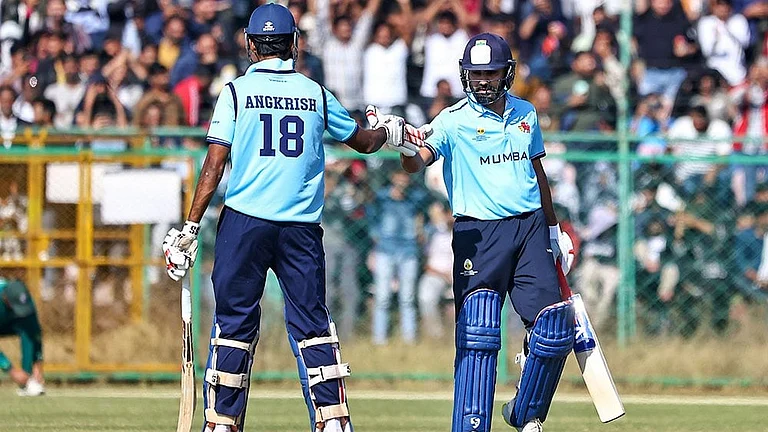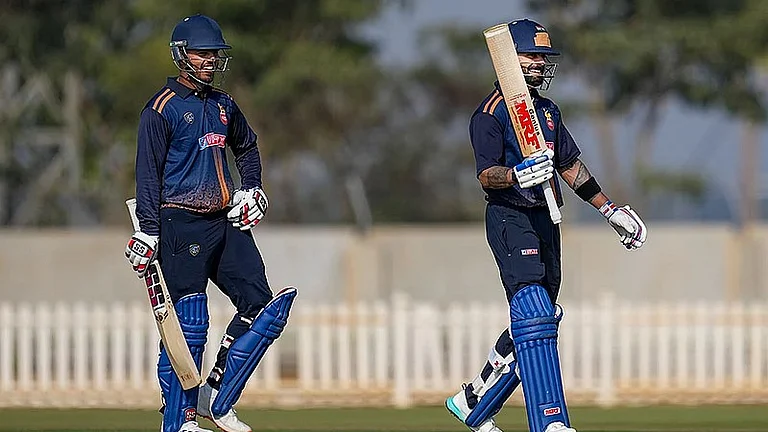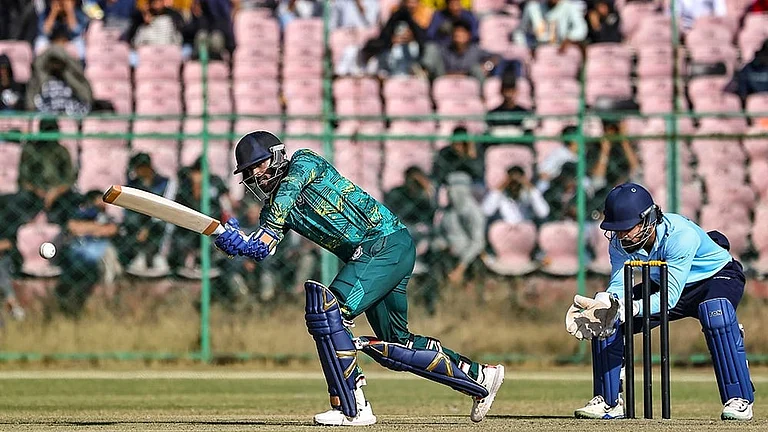When the pandemic hit the globe last year, 32-year-old Mohammed Mazhar’s world cracked.
The designer from the small town of Saharanpur, Uttar Pradesh, who works with a team of 200 people from India’s marginal communities, was featured in the 2018 edition of Forbes India 30 under 30 and has a huge base of buyers in Qatar, Kuwait and Saudi Arabia, not to mention a celebrity clientele in India, including Sonam Kapoor, Anushka Sharma, Deepika Padukone, Taapsee Pannu and Salman Khan among others. But even now, a year later, he worries that the pandemic will shatter his business.
“It has always been challenging to operate an international business from my hometown, Saharanpur. But the business was running smoothly and in 2019 the fashion industry was at its peak,” says Mazhar. “When the pandemic hit and lockdown restrictions were announced, however, we lost both our international buyers and Indian retail. Many international buyers cancelled contracts with us or re-negotiated terms, and the stock we had already produced for them was left dead.”
Mazhar’s concern about the future of his business is less about the business itself than the families his business supports. “My business indirectly runs the households of the 200 people I work with,” he explains. “When the lockdown began, the very first challenge I faced was to provide them with their basic needs. After all, they have made me the designer I am today. Then I saw how the lockdown affected other businesses and the number of people who lost their jobs. That’s when I learned once and for all that sustainable fashion is the need of both the Indian and the international fashion industries.”
“Retail suffered a lot, and people who had a big infrastructure and a big setup were the worst affected,” says designer Samant Chauhan. “Our brand had expanded recently, but because of the pandemic, revenue went down and it became extremely difficult for me to take care of my staff. It made me think of ways to sustain our brand for the coming years. Before the pandemic struck, we were in the race of commercialism. During the pandemic, I thought about how we want to take our brand forward in the coming years. Meanwhile, we are just cutting down expenditure to survive.”
ALSO READ: Clothes For The Emperor!

Model: Diksha Thapa, Outfit: Rahul Mishra. Hair: Sneha Chauhan, Makeup: Dinky Maggo
According to the State of Fashion 2021 report by Business of Fashion and McKinsey & Company, “A full recovery of global fashion sales to pre-crisis levels will not come until the third quarter of 2022 at the earliest.” The report adds: “Indeed, fashion is expected to be among the slowest-recovering discretionary spend categories.”
The foundation of the fashion industry worldwide has always been social occasions and events. People have always wanted to look good not only for themselves, but in the eyes of other people. People have always wanted to be seen as leaders—trendsetters—in their social sets. This is why the fashion industry’s basis of creativity, as also of marketing, publicity and sales, has always been glamorous events and parties.
But as governments around the world imposed blanket lockdowns in their countries due to the pandemic, isolating the majority of the global population in their homes for the first time in history, the very foundation of the fashion industry was destroyed. No parties. No hangouts. No lunches with friends. No strutting to the water cooler in the workplace. No reason, frankly, to wear anything but pajamas. Little money, also, for consumers to spend on frippery, given the way jobs were lost and salaries were cut in the last two years.
ALSO READ: Wanted! A Desi Model For Fashion Education
With no precedent to deal with a situation like this, the Indian fashion industry in the last year or so had no choice but to adapt for the sake of some financial security. And for the most part, in line with the Western fashion industry, that meant moving their businesses online, at least for the moment.
“Even though digital shows often lack the immediacy and energy of live events, we have had to reorient our strategies by focusing on the digital space for communication, marketing and sales,” says designer David Abraham of the label Abraham & Thakore.
Before the Covid-19 virus hit the planet, most designers had not been fond of the digital space. While acknowledging its value as a marketing and publicity tool, they never believed it could be the sole platform for a business based on tactility. But the physical isolation forced upon us all by the pandemic changed our behaviour. Consumers today have learned to perceive the virtual world as though it is the real thing.
“True, fashion is a tactile industry, but the digital market allows consumers to speak directly to designers and ask them everything about a piece of clothing and how it can be customised,” explains Mandar, a fashion public relations executive and stylist who works with The Yellow Dot, an agency that manages nine emerging designers. “That sort of barter has led to more sales, more brand-building. It has brought the customers and the manufacturers closer, creating a new age of fashion.”

(L-R) Diksha Thapa in an Arjun Saluja outfit, Hair: Sneha Chauhan, Makeup: Dinky Maggo; Sonalika Sahay in a Rajesh Pratap outfit for Satya Paul, Hair and makeup: Dinky Maggo; Kajal Chaudhary in an outfit by Mohammed Mazhar, Hair: Sneha Chauhan, Makeup: Nandini Aggarwal.
Digitalisation was and still is the subject of much soul-searching for designer Raghavendra Rathore and his team. Because he focuses primarily on bespoke wear, it was easy for him to serve his customers during the lockdown via Zoom consultations. But even as in-person events begin to be held again, he wonders whether it makes sense to go more deeply into digital than this.
“In the age of fast-changing trends, you have to keep an eye on consumers who have the awareness and exposure to a gamut of media channels and sources,” says Rathore. “The brick-and-mortar vs online commerce debate will last for some time to come.”
That’s because as much as digital media has come to the rescue of Indian designers, it does not at this time appear to be a long-term solution for the real business of fashion—actual sales. Until the industry can work out a business model to cope with the speed of digital media, where the users’ primary impulse is to seek the next big thing, there will come a time when the online silver lining will turn out to actually be the big grey cloud itself.
Says designer Payal Jain, “Individual orders and sales may have grown exponentially through digital platforms, but the wholesale business of booking orders has taken a hit. The novelty of waiting for a new collection has also gone, and many brands have to now create separate collections for the wholesale and retail segments in an effort to preserve the sanctity of the new season’s look until it hits the stores and online platforms. The retail customer also becomes easily bored and lacks loyalty to the brand because of the increasing glut of options available through social media handles.”
For years, fashion industry observers have wondered: Who creates trends? Is it the designers hunched over their drawing boards or the buyers who react to changing circumstances?
The pandemic has an emphatic answer to this question—one that will be relevant for the next few years. It’s the buyers.
“The way the consumer is dressing has changed,” says designer Arjun Saluja. “People now want quality products that will last a long time and have more utility than they earlier did. They are also not spending the way they used to. So one of the things we did in the pandemic was learn to minimise waste.”
Saluja’s ‘Sifer’ collection uses natural dyes made from discarded onion skin. “We have been working on this technique since the pandemic began and we will continue to do so,” he says. “We have also learned how to cut and make garments to ensure that the customer can use them for a longer period of time.”
Meanwhile, Rathore believes that designers will have to change along with their customers’ needs. “Creatively solving design issues has become the new anthem for designers,” Rathore says. “We have all had to shift gears around the issue of readapting design, clothes and services offered to customers. Since the experience people are looking for has changed, their clothes need to be an accent to their personality and last for a lifetime.”
The phrases ‘long-lasting’ and ‘last for a lifetime’ almost sound ironic when used by designers to refer to the way the pandemic has changed the needs of consumers. For the last 10-15 years, scientists investigating climate change have placed a major part of the blame for it directly at the door of the fashion industry, which till 2019 pushed consumers to ‘stay on trend’ by buying the very latest style on the market, even if the previous latest style had only been released a month earlier.
The pace at which the fashion industry functioned and the rampant consumerism it encouraged led to “an environmental and social emergency”, according to the United Nations. The worldwide fashion industry is known to produce more harmful emissions than even the aviation industry, and the amount of natural resources it consumes to make consumers buy its products is literally destroying the planet. So even before the Covid-19 pandemic struck, designers had been talking about making the industry more sustainable.
However, not much of that talk translated into action until the pandemic put the fear of spending money into consumers, making ‘slow fashion’ or ‘conscious fashion’ the industry’s new trend.
“Since the pandemic began, buying capacity has gone down hugely,” says designer Siddhant Beriwal, who showcased a collection at the FDCI x Lakme Fashion Week this October. “People take the need for an outfit into consideration when they are buying and they want their outfits customised. They have also become more aware of textiles because of the way the artisans suffered during the lockdown. This new consciousness about ethical fashion and sustainable clothing has impacted their buying patterns.”
This change in consumer patterns is leading designers to think about how fashion can be made sustainable. Keeping climate change in mind, Rathore, for instance, is playing with the idea of local fashion. “This involves two aspects,” he says. “First, companies will need to engage better with local consumers, make strategic investments in markets witnessing a stronger recovery and unlock new opportunities to keep customers shopping. The second aspect is about empowering local communities; standing strong with society and finding various ways to give back and rebuild confidence in our social fabric.”

(Left) Nitish Anand in an outfit by Samant Chauhan; (centre) Sonalika Sahay in an outfit by Rahul Mishra; (right) Offbeat Valerie Buscayret in an outfit by Samant Chauhan
Like Saluja with his onion skin-dyed collection, labels have started conversations around harmless ways of producing clothes that are fashionable, eco-conscious and ethical.
For example, Indo-German brand Cocccon, which showcased their collection, Abundant Paradise, at the Lakme Fashion Week 2021, looked at luxury nightwear, avant garde dresses, streetwear, scarves and jackets made from ‘peace silk’, a type of silk that is produced without harming or killing the silkworms.
“A new conscious buying behaviour has grown in the last couple of years among the consumers, especially during the pandemic,” says designer Chandra Prakash Jha of Cocccon. “They have witnessed extreme weather conditions across the globe and know fashion is also responsible for this in many ways. They want to buy less and want to keep it in the sustainable bracket. There are many reports about Gen Z asking brands for more transparency and traceability. The new generation wants a safe future for themselves and so they have begun demanding action from the fashion brands.”
The churn within the industry prompted by circumstances outside it is not necessarily a bad thing. In fact, given that India’s fashion industry only began to coalesce about 20 years ago, according to Sunil Sethi, president of the Fashion Design Council of India, it may well be a great thing. An industry this young, filled with so many talented and ambitious designers, perhaps needed to know that the world can often be unsettled and that for a business or an industry to survive, truly creative thinking is needed.
Designer Rahul Mishra, for example, has a radical idea involving reverse migration that, if turned into a viable plan, will solve several problems at once—from the overcrowded cities and rural unemployment that led to the deadly long march of migrant workers during the lockdown last year, to the fashion industry’s need to clean up its natural resources-destroying act.
Craftspeople, Mishra explains, often have to move to cities because that is where their skills are in demand. This means that the rural landscape is populated by stories of migration, separation and struggle. “But if, instead of seeing the primary objective of luxury as consumption, we seek to create a system that explores participation by inviting the craftsmen who are working in different slum districts of Indian metropolises to work from their villages and contribute to their families while living with them, it will support the circular economy of their villages and become part of an ethically sustainable system of production,” says Mishra.
Even now, in industrialised India, more than 45 million people earn their livelihood via crafts, Mishra continues. “Returning to the slower processes of production and increased human involvement will create larger employment opportunities and in turn support the craft community of the country and beyond,” he adds. “When you employ an individual in a village, you do not only support one family, you create employment for the families of all those that are connected with them, such as the milkman, shopkeepers, and even postmen.”
As much as fear of pandemics has made ‘slow fashion’ the new fashion industry buzzword, Sunil Sethi does not believe that the market for it will be sustainable without some very deep thinking.

(From left) Designers Rahul Mishra and Samant Chauhan, FDCI president Sunil Sethi
“Only a very niche group of people are genuine believers in slow fashion,” Sethi says. “The fact is that we are so affected by the consumerism of the West that in social media every day you will discover new [fashion] collections. But I believe in the business of fashion too. So there has to be a model that allows the business of fashion and slow fashion to work hand in hand.”
Meanwhile, the fashion industry, like the consumers it caters to, is in two minds about how it wants the future to unfold. On the one hand, still shaken by the pandemic, designers and consumers hope for a more thoughtful, more sustainable world; a world in which less is more. On the other hand, much of the world’s population is hoping they can go back to business as usual soon.
In India, as more in-person events begin to take place even as fears of a third wave of the pandemic remain, the fashion industry has compromised a little. The FDCI x Lakme Fashion Week held this October was a ‘phygital’ or combination of digital and physical event, with 10 in-person shows and more than 20 digital shows.
Says Jaspreet Chandok, head, fashion and lifestyle, RISE Worldwide, and business head of Lakme Fashion Week, “During the pandemic, we have seen remarkable growth for Indian designers on online shopping platforms. We look forward to seeing audiences not only being inspired by the fashion that walks the runway, but also having immediate access to purchase it. At the same time, we are also looking forward to seeing a more empowered and discerning audience that is looking for sustainable solutions in what they wear.”
Mohammed Mazhar made it clear what his business’s future will be via his recent collection, ‘Meri Pyaari Khaat’, presented at the FDCI x Lakme Fashion Week. Based on his childhood memories of the weavers of the string cots dotted all over rural north India, his focus will be on the people without whom he would not have a business in the first place.
“As one of the Forbes India 30 under 30, I was financially strong. But when the pandemic began, I interrogated myself on what the end limit of these financial figures could be and learned that the money could stretch only so far as to feed 200 people and their families for perhaps a few months,” Mazhar says. “This thought was scary; filled with doom. I asked for the help of bigger organisations, even the FDCI, but learned that few people care about small towns. Their priorities are the metros. Even so, they were in the same boat as I was.”
The fashion industry will have to change to survive. What these changes will comprise is still unknown. Mazhar, for example, has no idea what he should do any more.
“The consumers seem confused. Prices of fabrics and raw materials have shot up. Certain quality materials have disappeared from the market because they couldn’t be produced during the lockdown. I am confused. What should I produce? When should I produce it? How should I produce it? It feels as though I am on the first chapter of my economics textbook in standard 11.”
All Mazhar knows is this: “If there is one more lockdown, it will be the end. We will be shattered.”
***
Industry That Isn’t Really One
The Indian fashion industry, according to Sunil Sethi, president of the Fashion Design Council of India, is not a genuine industry at all. At least, not as yet. It is an industry in the sense that it employs huge numbers of people from designers to tailors, merchandisers, retailers, fabric producers, models, photographers, public relations people and a whole long list of other professionals in adjacent fields. But since it remains overwhelmingly unorganised and therefore uncountable, it cannot be termed a genuine industry.
Though the State of Fashion 2019 report points out that India is rich in raw materials like cotton, silk, wool and jute, and that the country’s labour costs are significantly lower than those of, say, China, most Indian designers are simply unable to take advantage of this for various reasons, among them lack of capital, says Sethi.
“Young designers are unable to take loans against simple orders. So you really need to have some property in your name (to be able to set up a unit),” Sethi points out. “The industry is living in two worlds. In one world, there are designers who have well established factories. But there are also designers who still work in basements and small units and workshops.”
And even the best of business plans can find themselves knotted in the red tape that India’s bureaucracy is so good at emitting. “While the government has many schemes, designers need people to run around the various government departments and help them with the paperwork if they want to establish themselves and to become part of the industry,” says Sethi. “It takes time to register medium and small-scale industries.”
Designers also have to deal with the popular perception of luxury Indian fashion that it is primarily bridal wear. The perception is both true and not true. According to Sethi, the word ‘bridal’ today does not necessarily mean only wedding wear. It also means couture and occasion wear. “That is the market that tends to be more luxury-oriented,” Sethi explains. “So most designers who are in the ready-to-wear market, the prêt market, are shifting to bridal wear. “
Designer Wajahat Rather agrees. “The Big Fat Indian Wedding is estimated to be worth over Rs 1,00,000 crore, and wedding apparel makes up about Rs 10,000 crore of that. So designers will do anything to cash in on this market,” Rather says. “Many young designers start with a more prêt approach, but over a period of time, they end up making more bridal wear. That’s because about 80 per cent of most fashion business turnovers comes from the bridal market, of which 40 per cent comes from wedding lehengas.”
The Indian luxury market, according to Sethi, has about eight and a half million luxury consumers. “It is said that the ethnic wear market is close to 20 billion. The younger generation wants to imbibe the luxury ethos and this is reflected in bridal wear,” he says.
For a fashion designer who had to shut down two stores due to the pandemic, Samant Chauhan seems remarkably upbeat. “I think a lot of new brands will grow after the pandemic,” says Chauhan. “Because people will buy from the younger lot (of designers). Consumers are spending their money very wisely, so younger brands have more opportunity.”
(This appeared in the print edition as "The E-go Collection In Metaverse")
(Edited by Kushal Gulab, Inputs by Srishti Jha)


























